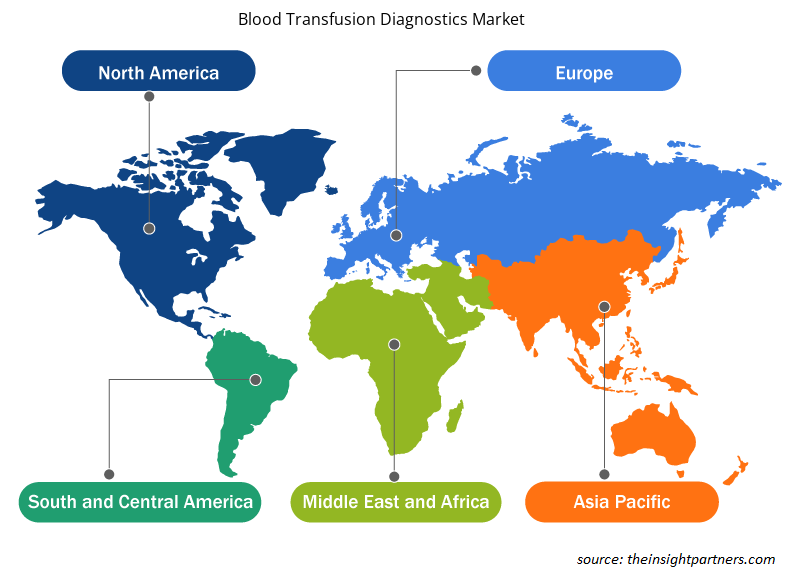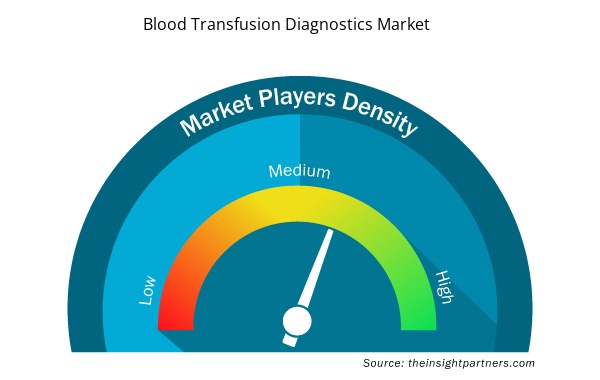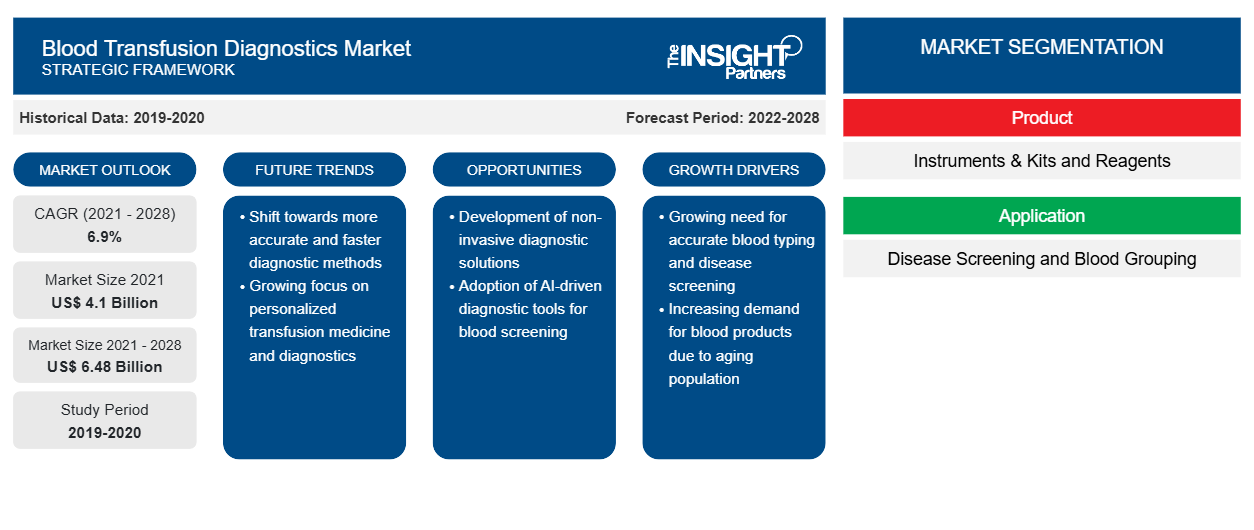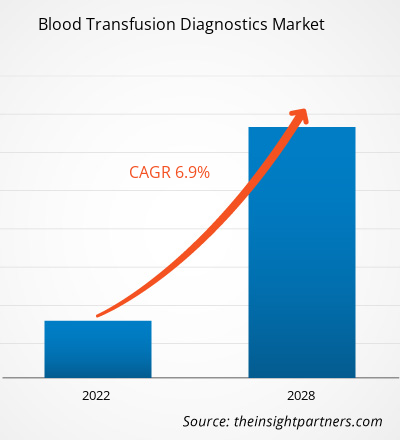[調査レポート] 輸血診断市場は、2021年の40億9,693万米ドルから2028年には64億8,375万米ドルに成長すると予想されています。2022年から2028年にかけて6.9%のCAGRで成長すると予測されています。
輸血診断は、患者に輸血する前に血液に対して行われる検査です。輸血は、献血された血液またはその成分を静脈内投与経路を通じて患者の体内に輸血する一般的な処置です。各血液単位は、副作用や感染の伝播を防ぐための病気検出検査を含む血液型の識別と血液スクリーニングを意味する血液型検査を受ける必要があります。
このレポートは、世界の輸血診断市場に関する洞察と詳細な分析を提供し、市場動向、技術の進歩、市場のダイナミクス、世界の主要市場プレーヤーの競合状況分析など、さまざまなパラメーターに重点を置いています。また、すべての地域の市場に対するCOVID-19パンデミックの影響も含まれています。COVID-19パンデミックは、世界の輸血診断市場の成長に悪影響を及ぼしました。政府によって課された厳格な制限により収益が大幅に減少し、実施された外科手術の数が減少しました。これらのサービスは主に、整形外科や心臓手術など、失血量の多い手術で使用されます。実施された手術数が減少したため、輸血の需要が減少しました。例えば、米国医師会が発表したデータによると、COVID-19パンデミックにより、米国で実施された外科手術の総数は48%減少したと推定されています。しかし、パンデミックの制限が正常化した後、外科手術の量は通常のレベルに戻りました。
要件に合わせてレポートをカスタマイズする
このレポートの一部、国レベルの分析、Excelデータパックなど、あらゆるレポートを無料でカスタマイズできます。また、スタートアップや大学向けのお得なオファーや割引もご利用いただけます。
- このレポートの主要な市場動向を入手してください。この無料サンプルには、市場動向から見積もりや予測に至るまでのデータ分析が含まれます。
地理に基づく洞察
地域別に見ると、世界の輸血診断市場は、北米(米国、カナダ、メキシコ)、欧州(フランス、ドイツ、英国、スペイン、イタリア、その他の欧州)、アジア太平洋(中国、インド、日本、オーストラリア、韓国、その他のアジア太平洋)、中東およびアフリカ(サウジアラビア、UAE、南アフリカ、その他の中東およびアフリカ)、南米および中米(ブラジル、アルゼンチン、その他の南米および中米)に区分されています。
市場分析
臓器移植手術の増加による輸血の必要性
臓器移植は、臓器不全の場合に行われる外科手術です。通常、臓器移植手術は、慢性腎臓病(CKD)、多発性嚢胞腎、嚢胞性線維症、先天性心疾患など、移植を必要とする慢性疾患の増加により、心臓、肝臓、腎臓、およびその他のさまざまな臓器に対して行われます。これらの手順は通常数時間かかり、大量の出血があり、輸血が必要になります。たとえば、United Network for Organ Sharing(UNOS)によると、米国で実施されている臓器移植は 継続的に増加しており、2021年には41,000件以上の移植が行われました。同様に、世界移植登録データによると、スペインは2019年にヨーロッパのすべての臓器提供の20%を占め、世界全体では6%を占めました。オーストラリアの臓器提供率は最近改善しており、2019年には人口100万人あたり21.8人に上昇しました。
同様に、カナダでは人口 100 万人あたり 22.2 人のドナーがおり、着実に改善しています。これは、臓器提供を担当する集中治療医である「ドナー医師」の数字に一部起因しています。世界移植登録によると、2019 年の中国のドナー数は 5,818 人で、人口 100 万人あたり 4.1 人、インドは 715 人で、人口 100 万人あたり 0.5 人でした。一方、ロシアは 100 万人あたり 5.1 人で、わずかに高い割合でした。移植コーディネーターと協力した官民パートナーシップは、継続的な輸血を必要とする臓器移植の改善に大きく貢献しました。発展途上国と先進国の両方で、臓器移植手術が増加しています。たとえば、インドやシンガポールなどの発展途上国は、アジア太平洋地域の医療ツーリズムの 目的地として浮上しています。各国は、より優れた高度な医療を提供するという点で進歩しています。臓器移植のニーズの高まりは、世界中で輸血診断の需要を促進する主な要因の 1 つです。
製品ベースの洞察
製品に基づいて、世界の輸血診断市場は、機器とキット、試薬に分かれています。2021年には、機器とキットのセグメントが大きな市場シェアを占めました。同じセグメントは、2022年から2028年にかけて市場でより高いCAGRを記録すると予想されています。
アプリケーションベースの洞察
アプリケーションに基づいて、世界の輸血診断市場は、疾患スクリーニングと血液型判定に分かれています。疾患スクリーニングセグメントは2021年に大きな市場シェアを占め、予測期間中に高いCAGRを記録すると予想されています。
輸血診断市場の地域別分析
予測期間を通じて血液診断市場に影響を与える地域的な傾向と要因は、Insight Partners のアナリストによって徹底的に説明されています。このセクションでは、北米、ヨーロッパ、アジア太平洋、中東およびアフリカ、南米および中米にわたる血液診断市場のセグメントと地理についても説明します。

- 輸血診断市場の地域別データを入手
輸血診断市場レポートの範囲
| レポート属性 | 詳細 |
|---|---|
| 2021年の市場規模 | 41億米ドル |
| 2028年までの市場規模 | 64.8億米ドル |
| 世界のCAGR(2021年~2028年) | 6.9% |
| 履歴データ | 2019-2020 |
| 予測期間 | 2022-2028 |
| 対象セグメント | 製品別
|
| 対象地域と国 | 北米
|
| 市場リーダーと主要企業プロフィール |
|
輸血診断市場のプレーヤー密度:ビジネスダイナミクスへの影響を理解する
輸血診断市場は、消費者の嗜好の変化、技術の進歩、製品の利点に対する認識の高まりなどの要因により、エンドユーザーの需要が高まり、急速に成長しています。需要が高まるにつれて、企業は提供を拡大し、消費者のニーズを満たすために革新し、新たなトレンドを活用し、市場の成長をさらに促進しています。
市場プレーヤー密度とは、特定の市場または業界内で活動している企業または会社の分布を指します。これは、特定の市場スペースに、その規模または総市場価値と比較して、どれだけの競合相手 (市場プレーヤー) が存在するかを示します。
輸血診断市場で事業を展開している主要企業は次のとおりです。
- グリフォルス、SA
- F.ホフマン・ラ・ロシュ株式会社
- イムコア株式会社
- バイオ・ラッド ラボラトリーズ株式会社
- アボット
免責事項:上記の企業は、特定の順序でランク付けされていません。

- 輸血診断市場のトップキープレーヤーの概要を入手
エンドユーザーベースの洞察
エンドユーザーに基づいて、世界の輸血診断市場は、血液銀行、病院、診断研究所、および血漿分画 会社に分類されます。血液銀行セグメントは、2021年に最大の市場シェアを占めました。同じセグメントは、2022年から2028年にかけて市場で最高のCAGRを記録すると予想されています。
世界の輸血診断市場のプレーヤーは、製品の発売や拡張を含む有機的な戦略を採用し、世界中でその足跡と製品ポートフォリオを拡大し、高まる需要に対応しています。市場の主要プレーヤーは、Grifols、SA、F. Hoffmann-La Roche Ltd、Immucor、Inc.、Bio-Rad Laboratories、Inc.、Abbott、Thermo Fisher Scientific Inc.、Ortho Clinical Diagnostics、DiaSorin SpA、Quotient Limited、およびBAG Diagnostics GmbHです。
- 過去2年間の分析、基準年、CAGRによる予測(7年間)
- PEST分析とSWOT分析
- 市場規模価値/数量 - 世界、地域、国
- 業界と競争環境
- Excel データセット


- Biopharmaceutical Tubing Market
- Compounding Pharmacies Market
- Artwork Management Software Market
- Vertical Farming Crops Market
- Sterilization Services Market
- Power Bank Market
- Foot Orthotic Insoles Market
- Trade Promotion Management Software Market
- Playout Solutions Market
- Medical Enzyme Technology Market

Report Coverage
Revenue forecast, Company Analysis, Industry landscape, Growth factors, and Trends

Segment Covered
This text is related
to segments covered.

Regional Scope
North America, Europe, Asia Pacific, Middle East & Africa, South & Central America

Country Scope
This text is related
to country scope.
よくある質問
Global blood transfusion diagnostics market is segmented by region into North America, Europe, Asia Pacific, Middle East & Africa, and South & Central America. In North America, the U.S. is the largest market for blood transfusion diagnostics market. The growth of the market in North America is expected due to the factors such as increasing surgical procedures for chronic health conditions, rising collaborative agreements between key players, and growing progress in the health system for blood transfusion diagnostics. However, the improvement in blood transfusion management, increasing prevalence of sepsis and thalassemia, and the introduction of advanced molecular platforms are the key factor responsible for the Asia-Pacific regional growth for blood transfusion diagnostics accounting fastest growth of the region during the coming years.
Grifols, S.A.; F. Hoffmann-La Roche Ltd; DiaSorin S.p.A.; BAG Diagnostics GmbH; Abbott; Bio-Rad Laboratories, Inc.; Immucor, Inc.; Thermo Fisher Scientific Inc.; Ortho Clinical Diagnostics; and Quotient Limited are among the leading companies operating in the blood transfusion diagnostics market.
The blood banks segment dominated the global blood transfusion diagnostics market and accounted for the largest market share of 40.23% in 2021.
Based on application, disease screening segment took the forefront lead in the worldwide market by accounting largest share in 2021 and is expected to continue to do so till the forecast period.
Based on products, instruments and kits segment took the forefront lead in the worldwide market by accounting largest share in 2021 and is expected to continue to do so till the forecast period.
Blood transfusion diagnostics refers to tests performed on blood and blood components before they are transfused to patients. A blood transfusion is a common procedure in which donated blood or blood components are transfused into the patient's body through an intravenous line (IV). Each unit of blood must undergo blood typing, which refers to the identification of blood type and blood screening, including disease detection tests to avoid side effects or transmission of infection. Blood screening before transfusion is performed through instruments, kits, and reagents to identify various diseases, such as HIV, hepatitis B, hepatitis C, Zika, and different viruses and infections.
Rapid increase in chronic diseases and increasing need for blood transfusion due to rise in organ transplants surgeries are the most significant factors responsible for the overall market growth.
Trends and growth analysis reports related to Life Sciences : READ MORE..
The List of Companies - Blood Transfusion Diagnostics Market
- Grifols, S.A.
- F. Hoffmann-La Roche Ltd
- Immucor, Inc.
- Bio-Rad Laboratories Inc.
- Abbott
- Thermo Fisher Scientific Inc.
- Ortho Clinical Diagnostics
- DiaSorin S.p.A.
- Quotient Limited
- BAG Diagnostics GmbH
The Insight Partners performs research in 4 major stages: Data Collection & Secondary Research, Primary Research, Data Analysis and Data Triangulation & Final Review.
- Data Collection and Secondary Research:
As a market research and consulting firm operating from a decade, we have published and advised several client across the globe. First step for any study will start with an assessment of currently available data and insights from existing reports. Further, historical and current market information is collected from Investor Presentations, Annual Reports, SEC Filings, etc., and other information related to company’s performance and market positioning are gathered from Paid Databases (Factiva, Hoovers, and Reuters) and various other publications available in public domain.
Several associations trade associates, technical forums, institutes, societies and organization are accessed to gain technical as well as market related insights through their publications such as research papers, blogs and press releases related to the studies are referred to get cues about the market. Further, white papers, journals, magazines, and other news articles published in last 3 years are scrutinized and analyzed to understand the current market trends.
- Primary Research:
The primarily interview analysis comprise of data obtained from industry participants interview and answers to survey questions gathered by in-house primary team.
For primary research, interviews are conducted with industry experts/CEOs/Marketing Managers/VPs/Subject Matter Experts from both demand and supply side to get a 360-degree view of the market. The primary team conducts several interviews based on the complexity of the markets to understand the various market trends and dynamics which makes research more credible and precise.
A typical research interview fulfils the following functions:
- Provides first-hand information on the market size, market trends, growth trends, competitive landscape, and outlook
- Validates and strengthens in-house secondary research findings
- Develops the analysis team’s expertise and market understanding
Primary research involves email interactions and telephone interviews for each market, category, segment, and sub-segment across geographies. The participants who typically take part in such a process include, but are not limited to:
- Industry participants: VPs, business development managers, market intelligence managers and national sales managers
- Outside experts: Valuation experts, research analysts and key opinion leaders specializing in the electronics and semiconductor industry.
Below is the breakup of our primary respondents by company, designation, and region:

Once we receive the confirmation from primary research sources or primary respondents, we finalize the base year market estimation and forecast the data as per the macroeconomic and microeconomic factors assessed during data collection.
- Data Analysis:
Once data is validated through both secondary as well as primary respondents, we finalize the market estimations by hypothesis formulation and factor analysis at regional and country level.
- Macro-Economic Factor Analysis:
We analyse macroeconomic indicators such the gross domestic product (GDP), increase in the demand for goods and services across industries, technological advancement, regional economic growth, governmental policies, the influence of COVID-19, PEST analysis, and other aspects. This analysis aids in setting benchmarks for various nations/regions and approximating market splits. Additionally, the general trend of the aforementioned components aid in determining the market's development possibilities.
- Country Level Data:
Various factors that are especially aligned to the country are taken into account to determine the market size for a certain area and country, including the presence of vendors, such as headquarters and offices, the country's GDP, demand patterns, and industry growth. To comprehend the market dynamics for the nation, a number of growth variables, inhibitors, application areas, and current market trends are researched. The aforementioned elements aid in determining the country's overall market's growth potential.
- Company Profile:
The “Table of Contents” is formulated by listing and analyzing more than 25 - 30 companies operating in the market ecosystem across geographies. However, we profile only 10 companies as a standard practice in our syndicate reports. These 10 companies comprise leading, emerging, and regional players. Nonetheless, our analysis is not restricted to the 10 listed companies, we also analyze other companies present in the market to develop a holistic view and understand the prevailing trends. The “Company Profiles” section in the report covers key facts, business description, products & services, financial information, SWOT analysis, and key developments. The financial information presented is extracted from the annual reports and official documents of the publicly listed companies. Upon collecting the information for the sections of respective companies, we verify them via various primary sources and then compile the data in respective company profiles. The company level information helps us in deriving the base number as well as in forecasting the market size.
- Developing Base Number:
Aggregation of sales statistics (2020-2022) and macro-economic factor, and other secondary and primary research insights are utilized to arrive at base number and related market shares for 2022. The data gaps are identified in this step and relevant market data is analyzed, collected from paid primary interviews or databases. On finalizing the base year market size, forecasts are developed on the basis of macro-economic, industry and market growth factors and company level analysis.
- Data Triangulation and Final Review:
The market findings and base year market size calculations are validated from supply as well as demand side. Demand side validations are based on macro-economic factor analysis and benchmarks for respective regions and countries. In case of supply side validations, revenues of major companies are estimated (in case not available) based on industry benchmark, approximate number of employees, product portfolio, and primary interviews revenues are gathered. Further revenue from target product/service segment is assessed to avoid overshooting of market statistics. In case of heavy deviations between supply and demand side values, all thes steps are repeated to achieve synchronization.
We follow an iterative model, wherein we share our research findings with Subject Matter Experts (SME’s) and Key Opinion Leaders (KOLs) until consensus view of the market is not formulated – this model negates any drastic deviation in the opinions of experts. Only validated and universally acceptable research findings are quoted in our reports.
We have important check points that we use to validate our research findings – which we call – data triangulation, where we validate the information, we generate from secondary sources with primary interviews and then we re-validate with our internal data bases and Subject matter experts. This comprehensive model enables us to deliver high quality, reliable data in shortest possible time.


 このレポートの無料サンプルを入手する
このレポートの無料サンプルを入手する